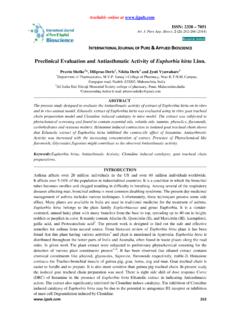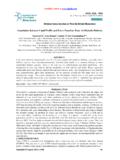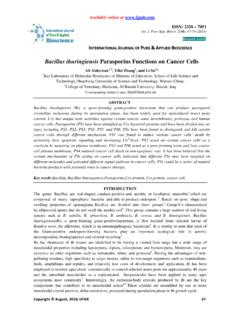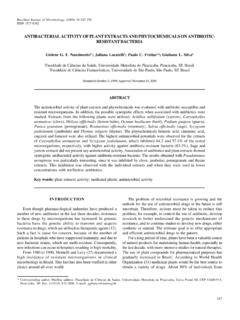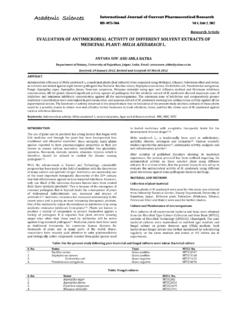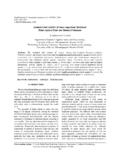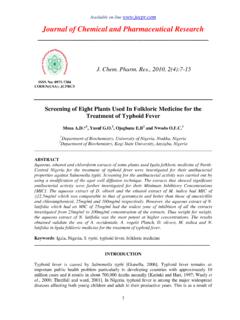Transcription of Antibacterial Activity and Phytochemical Profile of …
1 Available online at ISSN: 2320 7051. Int. J. Pure App. Biosci. 3 (3): 117-123 (2015). Research Article INTERNATIONAL JOURNAL OF PURE & APPLIED BIOSCIENCE. Antibacterial Activity and Phytochemical Profile of Green Tea, Black Tea and Divya Peya Herbal Tea Kaur, *, Kaur, S. and Rana, S. SUS College of Research and Technology, Tangori (Mohali), Punjab *Corresponding Author E-mail: ABSTRACT. Keeping in view the difference in processing techniques of different teas, the present study was planned to evaluate phytoconstituents present and Antibacterial Activity of various tea (Camellia sinensis) extracts against Staphylococcus, Streptococcus, Bacillus and multi-drug resistant E.
2 Coli. Phytochemical screening to identify major biologically active phytoconstituents in extracts of green tea, black tea and divya peya herbal tea showed the presence of alkaloids, flavonoids, tannins, saponins, reducing sugars and cardiac glycosides in all the tea extracts but steroids were present in black tea only. Ethanolic and methanolic extracts of different tea samples showed significant Antibacterial Activity against Staphylococcus, Streptococcus, Bacillus and E. coli isolated from soil samples of various locations. Results of zone of inhibition (ZOI) revealed that methanolic extract of green tea, black tea and divya peya herbal tea had highest Antibacterial Activity (ZOI , , respectively; , , respectively) against Bacillus and E.
3 Coli showed resistance to aqueous extracts of all tea samples. Results of Antibacterial Activity and Phytochemical screening showed that different processing techniques had no effect on the bioactive components present in tea samples but extraction solvent played important role in extraction of these components as evident from results of Antibacterial Activity . Overall study indicates that various types of tea can be used as an alternative medicine against the bacterial infections and cariogenic oral flora, opening a promising avenue of clinical applications in the preparation of specific and natural Antibacterial and anticariogenic remedies.
4 Keywords: Alkaloids, Black tea, E. coli., Herbal tea, Morphological INTRODUCTION. Tea is an aromatic beverage commonly prepared by pouring hot or boiling water over cured leaves of the tea plant Camellia sinensis (C. sinensis). After water, tea is the most widely consumed beverage in the world. It has a cooling, slightly bitter, and astringent flavour that many people enjoy. Consumption of tea (especially green) is beneficial to the health and longevity given its antioxidant, flavonoids, polyphenols and catechins content. Tea catechins have known anti-inflammatory and neuroprotective activities, help to regulate food intake1.
5 Teas of C. sinensis undergo different manufacturing processes. Green tea is produced by steaming (Japan). or panning (China) to prevent catechin oxidation by polyphenol oxidase2. Oolong tea is semi-fermented while black tea is fully fermented 3,4,5. Human studies suggest that green tea may contribute to a reduce the risk of cardiovascular disease and some forms of cancer, as well as promote oral health and other physiological functions such as antihypertensive effect, body weight control, Antibacterial and antivirasic Activity , bone mineral density increase, antifibrotic properties and neuroprotective powers6. Green tea contains mainly flavanols or catechins of epigallocatechin gallate (EGCG), epigallocatechin (EGC), epicatechin gallate (ECG), and epicatechin (EC).
6 Copyright June, 2015; IJPAB 117. Kaur, et al Int. J. Pure App. Biosci. 3 (3): 117-123 (2015) ISSN: 2320 7051. In black tea, the major polyphenols are thearubigins and theaflavins. The major theaflavins of black tea are theaflavin, theaflavin 3-gallate, theaflavin 3-gallate, and theaflavin 3,3-gallate. Tea polyphenols are also known for their Antibacterial Activity . In general, Antibacterial Activity decreases when the extent of tea fermentation is increased, implying stronger Activity in green tea than black tea. Green tea catechins, particularly EGCG and ECG, have Antibacterial Activity . Green tea can prevent tooth decay by inhibiting oral bacteria.
7 The Antibacterial Activity of black tea has also been reported7. Increased enzymatic oxidation of tea results in a decrease in catechin concentration and formation of complexes like theaflavins. Black tea undergoes complete fermentation, oolong tea undergoes partial fermentation, while green and white teas are unfermented8. There are number of reports on clinical uses of Camellia sinensis in various disorders particularly in cancer and diabetes that have shown promising results9. Swami Ram Dev Divya Peya herbal tea is an Ayurvedic drink, free from alcohol, having sweet taste &. the best substitute for tea. The main ingredient of Divya Peya is Ashwagandha which strengthens the physical body and relieves it from stress.
8 It is good for general health as it deals with various health issues in the body. It contains cardamom, cinnamon, clove, chandana, black pepper, long pepper, bay leaves, citraka, ashwagandha, shankha-puspi, tulasi, brahmi, dry ginger and saunf. It is boiled for more time than normal tea to boost the effectiveness of the herbs. The bay leaf used treats indigestion, flatulence, gastric, and acidity. The best quality of this drink is that it doesn't harm the unctuousness of milk, and is absolutely free from nicotine and caffeine10. Although much work has been done on the phytochemicals present and Antibacterial Activity of green and black tea but no report was found on Divya peya herbal tea, this prompted us to compare phytocontituents and Antibacterial Activity of green tea, black tea and Divya peya herbal tea.
9 MATERIAL AND METHODS. Preparation of Extracts of Tea Samples Aqueous, ethanolic and methanolic extracts of all the tea samples were prepared by dissolving 50gm tea/50ml solvent (water, ethanol and methanol) in soxhlet apparatus and subjected to extraction. Distillation was carried out for individual tea sample separately and filterate was vaporized to dryness and weighed. The stock solutions of crude extracts were prepared by dissolving the dried extract with respective solvent to obtain the final concentration of 10mg/ml. Antibacterial Activity of Extracts To check the Antibacterial Activity of extracts against bacteria, most prevalent oral bacteria were isolated from soil samples collected from different places by serial dilution method.
10 Isolated bacterial cultures were identified by morphology of colony and gram staining and by standard biochemical tests11. Disc diffusion method was used to check the Antibacterial Activity of tea extracts. Tea extracts were loaded on sterile individual discs and the loaded discs were placed on the surface of Muller Hinton Agar plates (MHA) plates. The extract was allowed to diffuse at least for 5 minutes and then kept for incubation at 37 C for 24-48 hours. After 24-48 hours of incubation plates were observed for appearance of zones of inhibition (ZOI) around the discs12. Zone of inhibition or depressed growth of microorganisms was measured and the Activity Index' (AI) for each extract was calculated.
